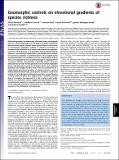| dc.contributor.author | Bertuzzo, Enrico | |
| dc.contributor.author | Mari, Lorenzo | |
| dc.contributor.author | Altermatt, Florian | |
| dc.contributor.author | Rodriguez-Iturbe, Ignacio | |
| dc.contributor.author | Rinaldo, Andrea | |
| dc.contributor.author | Carrara, Francesco | |
| dc.date.accessioned | 2017-01-09T18:48:52Z | |
| dc.date.available | 2017-01-09T18:48:52Z | |
| dc.date.issued | 2016-02 | |
| dc.date.submitted | 2015-12 | |
| dc.identifier.issn | 0027-8424 | |
| dc.identifier.issn | 1091-6490 | |
| dc.identifier.uri | http://hdl.handle.net/1721.1/106297 | |
| dc.description.abstract | Elevational gradients of biodiversity have been widely investigated, and yet a clear interpretation of the biotic and abiotic factors that determine how species richness varies with elevation is still elusive. In mountainous landscapes, habitats at different elevations are characterized by different areal extent and connectivity properties, key drivers of biodiversity, as predicted by metacommunity theory. However, most previous studies directly correlated species richness to elevational gradients of potential drivers, thus neglecting the interplay between such gradients and the environmental matrix. Here, we investigate the role of geomorphology in shaping patterns of species richness. We develop a spatially explicit zero-sum metacommunity model where species have an elevation-dependent fitness and otherwise neutral traits. Results show that ecological dynamics over complex terrains lead to the null expectation of a hump-shaped elevational gradient of species richness, a pattern widely observed empirically. Local species richness is found to be related to the landscape elevational connectivity, as quantified by a newly proposed metric that applies tools of complex network theory to measure the closeness of a site to others with similar habitat. Our theoretical results suggest clear geomorphic controls on elevational gradients of species richness and support the use of the landscape elevational connectivity as a null model for the analysis of the distribution of biodiversity. | en_US |
| dc.description.sponsorship | Swiss Federal Institute of Aquatic Science and Technology | en_US |
| dc.description.sponsorship | European Research Council. Advanced Grant Program (RINEC Project 227612) | en_US |
| dc.description.sponsorship | Swiss National Science Foundation (Projects 31003A_135622 and PP00P3_150698) | en_US |
| dc.description.sponsorship | Horizon 2020 Framework Programme (European Commission) (ECOPOTENTIAL Project 641762) | en_US |
| dc.language.iso | en_US | |
| dc.publisher | National Academy of Sciences (U.S.) | en_US |
| dc.relation.isversionof | http://dx.doi.org/10.1073/pnas.1518922113 | en_US |
| dc.rights | Article is made available in accordance with the publisher's policy and may be subject to US copyright law. Please refer to the publisher's site for terms of use. | en_US |
| dc.source | PNAS | en_US |
| dc.title | Geomorphic controls on elevational gradients of species richness | en_US |
| dc.type | Article | en_US |
| dc.identifier.citation | Bertuzzo, Enrico et al. “Geomorphic Controls on Elevational Gradients of Species Richness.” Proceedings of the National Academy of Sciences 113.7 (2016): 1737–1742. © 2015 National Academy of Sciences | en_US |
| dc.contributor.department | Massachusetts Institute of Technology. Department of Civil and Environmental Engineering | en_US |
| dc.contributor.department | Parsons Laboratory for Environmental Science and Engineering (Massachusetts Institute of Technology) | en_US |
| dc.contributor.mitauthor | Carrara, Francesco | |
| dc.relation.journal | Proceedings of the National Academy of Sciences | en_US |
| dc.eprint.version | Final published version | en_US |
| dc.type.uri | http://purl.org/eprint/type/JournalArticle | en_US |
| eprint.status | http://purl.org/eprint/status/PeerReviewed | en_US |
| dspace.orderedauthors | Bertuzzo, Enrico; Carrara, Francesco; Mari, Lorenzo; Altermatt, Florian; Rodriguez-Iturbe, Ignacio; Rinaldo, Andrea | en_US |
| dspace.embargo.terms | N | en_US |
| dc.identifier.orcid | https://orcid.org/0000-0003-2827-5615 | |
| mit.license | PUBLISHER_POLICY | en_US |
